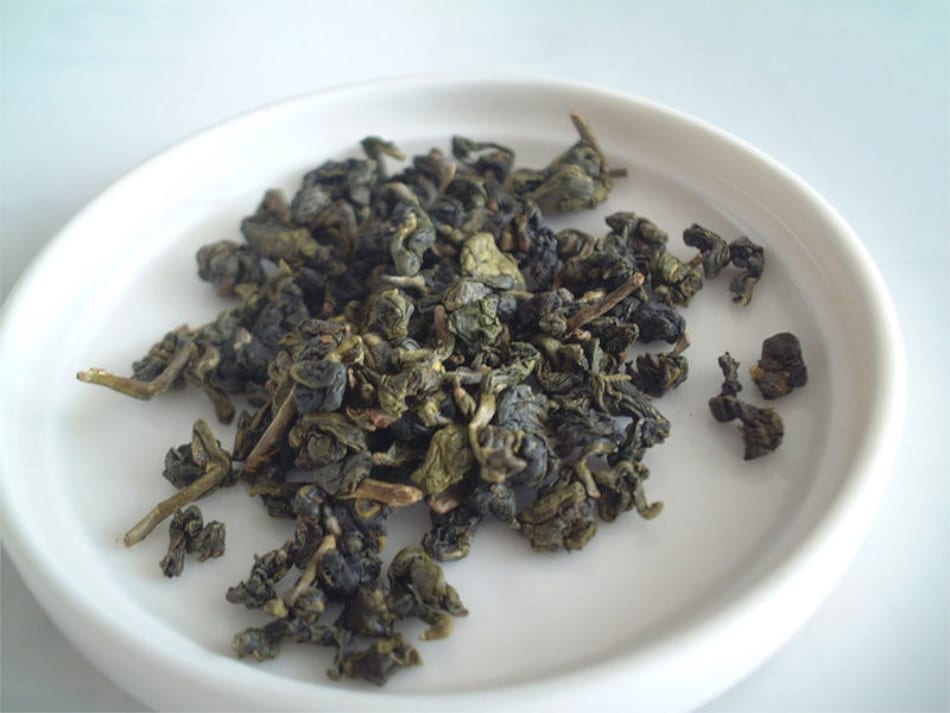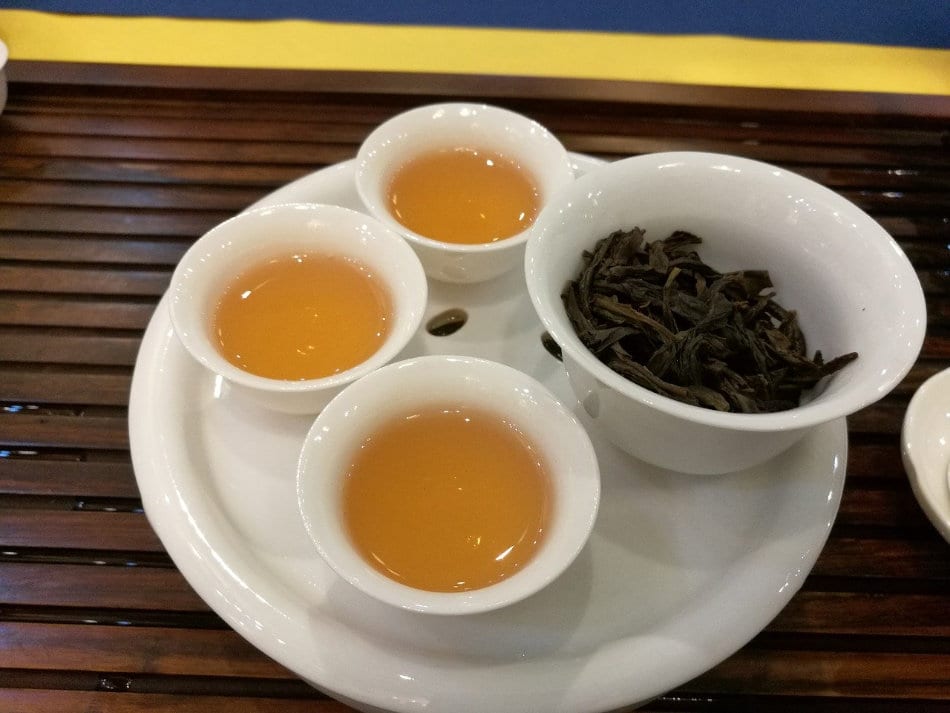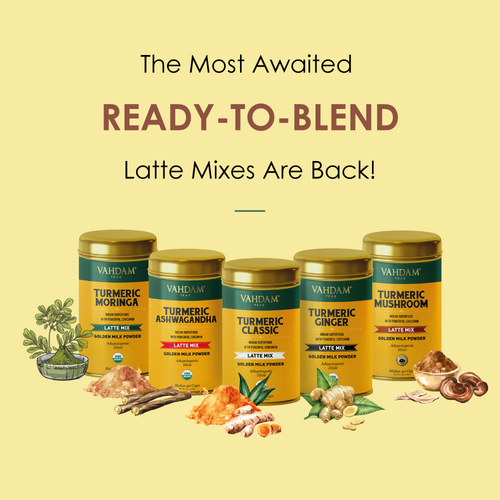Etymologically speaking, Oolong tea derives its name from two words, meaning “black” and “dragon” – a reference to the shape and color of the tea leaves. This semi-oxidized tea offers a perfect middle ground between the fully oxidized black tea and the barely oxidized green tea. Hence, this tea is excellent for those who do not like the strong bitter taste of black tea but don’t fancy the grassy notes of green tea either. Depending on the degree to which the tea leaves are oxidized (8—85 %), this tea is available in various flavor textures – from the lighter, more floral green variants to the deeper, more woody blacker teas.
The processing of the tea – right from picking to rolling – is integral to the flavor of Oolong. Shortly after the tea leaves are picked, they are withered and partially oxidized by keeping them out in the sun and then in the shade. After that, the tea leaves are basket-tossed to break down the cells on the surface of the leaves. The natural oxidation process is halted by roasting the leaves in a wok, either over charcoal or wood, which adds to the unique flavor of the tea. Finally, the leaves are curled or rolled into tight balls or thin strands. The rolling of the tea leaves is a crucial step, which defines the final flavor of the tea.
History of Oolong Tea
Three widely accepted theories explain the origin of Oolong tea.
If the “tribute tea” theory is believed, this tea was discovered in China’s Fujian province during the reign of the Tang dynasty. The tea’s predecessor, Beiyuan tea, was served to the emperor after being compressed into cakes, as was the tradition then. This tribute was then known as the Dragon-Phoenix cake after the two different types of tea found in the cake. Later, when the tea became popularised in its loose form, its name was changed to “black dragon” tea or oolong tea.
The second theory assigns the origin of Oolong to the Wuyi mountain region, with the tea named after the part of the Wuyi mountain where it was produced. This theory is supported by poems written during the Qing dynasty – the first instance of documentation recorded in Oolong’s history.
The third theory, which is the most famous legend, says that the tea was discovered by accident during the reign of the Qing dynasty in the province of Fujian. According to the legend, a tea farmer was picking tea one day when he got distracted by a deer that he set out to hunt. He only got back to the plucked leaves the next day, by which time the tea leaves had already started to oxidize. The result was a completely new flavor that was strong and sweet but without any bitterness. This tea farmer’s nickname was Oolong, after which the tea was named.
In the early 1800s, a Fujian tea merchant carried some Oolong seeds to Taiwan, which led to widespread tea production in that region. However, it was not before 1868, when John Dodd set up tea processing units in Taipai, that this tea began getting exported worldwide from Taiwan. Now, the cultivation of Oolong has spread to various parts of Asia, including even Indian and Nepal. However, the best oolong tea still comes from the Anxi or Fujian regions of China or Taiwan.

How to Prepare a cup of Oolong
Since the oxidation level of Oolong varies depending upon the type of tea, the quantity, brewing temperature, and steeping time are different for different variants. Hence, it is a good idea to request the vendor for specific brewing instructions. However, generally, Oolongs can be steeped at temperatures ranging anywhere between 180°F to 190°F, i.e., before the water reaches boiling point. And as a general rule of thumb, 1 teaspoon of rolled Oolongs and 1 tablespoon of longleaf Oolong can be used for 240 ml of water.
It is recommended to steep Oolong tea multiple times, for each steeping unfurls the leaves further, unlocking more decadent flavors. The same tea leaves can be steeped 3—5 times, offering a different flavor profile each time. When brewing Oolong, be careful not to over-steep the tea. The ideal steeping time is anywhere between 1 minute to 3. You can taste your brewed cup after a minute of steeping and check how much more you’d like to steep the tea, if at all. To get the best flavors out of this tea, brew your Oolong in a ceramic or clay vessel.
The Best way to Consume Oolong
The subtleties and different shades of Oolong’s flavor can be best enjoyed without any additives, such as milk or sweetening agents. However, the darker variants might require some sweetening for those who like the bitterness of their tea diluted. If you belong to this lot of tea-drinkers, please add some honey or sugar to your tea. However, adding milk runs the risk of taking away from this tea its interesting, complex flavors. This tea should be consumed black.

Oolong Food Pairing
Oolong tea tastes well when paired with fruits or fruity desserts, herby dishes, and smoked cheese slices due to its smoky and complex flavor. Ranging between green and black teas, Oolong offers a diverse taste profile that can be paired with a wide variety of food items, depending upon the type of tea. The lighter oolong teas go very well with sweet, rich seafood, such as scallops or lobster, while the darker ones, with their bolder complex flavors, go well with grilled and smoked meats.
Nutrition and Caffeine Levels in Oolong
A 240 ml cup of Oolong contains 10—60 mg of caffeine, depending upon the leaves’ level of oxidation. But, in general, Oolong tea is low in caffeine strength compared to the other darker teas. The calorie count of Oolong is 1 Kcal/cup. Oolong tea carries several minerals, such as Fluoride, Manganese, Potassium, Sodium, Magnesium, and Niacin. Oolong is considered suitable for health for it contains vitamins, minerals, amino acids, and many beneficial anti-oxidants.
Health Benefits of Oolong Tea
The health benefits of Oolong are varied. From helping in weight loss to improving heart, skin, hair, and bone health, Oolong is an excellent tea choice for health buffs.
Boosts metabolism, causing weight loss: Oolong burns fat faster by raising metabolism levels. Additionally, Oolong contains polyphenols that block fat-building enzymes.
Strengthens the immune system: Oolong carries anti-oxidant flavonoids that combat cellular damage—drinking Oolong boots the production of anti-bacterial protein, which leads to a robust immune response when fighting infections.
Lowers cholesterol levels: Oolong tea is known to reduce cholesterol, lowering the risk of cardiovascular diseases. The semi-oxidized oolong tea produces a perfectly sized polyphenol molecule that activates the enzyme lipase known to dissolve body fat.
Helps prevent diabetes: A study suggests that drinking 6 cups of Oolong tea regularly for 30 days allows patients suffering from type 2 diabetes. The tea helps reduce, even stabilize blood sugar levels. Additionally, the polyphenols in the tea increase insulin activity, which directly affects diabetics.

Improves brain health: As is the case with any tea, the caffeine in Oolong helps revitalize the mood and beat stress. Additionally, the amino acid theanine present in Oolong boosts attention and helps manage anxiety. The polyphenols in the tea are said to calm nerves and cast a soothing effect on the mind.
Lowers risk of cancer: Studies show that consuming a cup of Oolong daily reduces cancer risk by 4%. This tea is primarily known to reduce the risk of ovarian cancer among women.
Boost skin health: Oolong is excellent for those suffering from eczema, for this tea can suppress the allergic reactions linked to this skin condition. Additionally, the anti-oxidant present in Oolong helps keeps the skin vibrant and youthful by slowing down the aging process.
Helps form strong bones: Regular Oolong drinkers are less likely to lose the mineral density of their bones. Additionally, this tea contains magnesium and calcium, which are suitable people for diabetes health. This tea is recommended for those who have osteoporosis.
Promotes dental health: Acid production and bacterial growth are hindered by Oolong, which implies that the tea helps with tooth decay and plaque build-up.
Oolong Tea Beverage Recipes
Orange Oolong:
Hot orange juice mixed with Oolong tea makes for a refreshing, tasty breakfast beverage, which is also very easy to make.
To make this drink, follow the steps below:
- Bring a cup of water to boil and cut and squeeze orange slices in a juicer.
- Pour hot water over the orange pulp to help extract more of the juice.
- Add a tea bag of oolong to the mix and let it rest for about 5 minutes.
- Remove the tea bag, add honey or sugar to taste, stir, and enjoy.
Oolong Maple Old Fashioned
To woo your guests at a party with this delicious cocktail, get your hands on the following ingredients:
- 2 tsp of loose leaf or two sachets of Oolong
- 1 cup of water
- 2 tsp maple syrup
- A dash of aromatic bitters
- A few orange peels
- 60 ml bourbon
- Ice cubes
First and foremost, brew a cup of Oolong and let the tea come down to room temperature. In a cocktail glass, add the maple syrup, aromatic bitters, and stir until the mixture is blended. Add a couple of ice cubes to the glass along with the orange peel. Now pour 60 ml of bourbon and 90 ml of the oolong tea. Garnish with mint leaves and enjoy.
References:
- https://www.teavivre.com/info/oolong-tea-history.html
- https://www.artoftea.com/what-is-oolong-tea
- https://www.newworldencyclopedia.org/entry/Oolong_tea
- https://tea101.teabox.com/a-brief-history-of-the-oolong/
- https://www.teasenz.com/chinese-tea/the-origin-of-oolong-tea.html
- https://www.teatulia.com/tea-varieties/what-is-oolong-tea.htm
- https://teafloor.com/blog/cultural-history-of-oolong-tea/
- http://www.rivertea.com/blog/beginners-guide-pairing-tea-food/
- https://www.twinings.co.uk/about-twinings/latest-news-and-articles/food-pairing-with-tea
- https://www.healthline.com/nutrition/oolong-tea-benefits#section2
- https://www.lifehack.org/articles/lifestyle/10-amazing-benefits-oolong-tea-you-didnt-know.html
- https://www.stylecraze.com/articles/best-benefits-of-oolong-tea-for-skin-hair-and-health/#gref
- https://www.nicolaspujol.com/hot-orange-juice-oolong-tea/
- https://www.sipsby.com/blogs/tea-recipes/oolong-maple-old-fashioned



